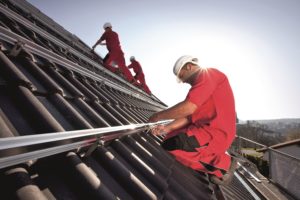 [1]It is important for all installations that the solar energy system is securely fixed to the roof – and every roof has its own specific requirements. I would like to take the opportunity with this and other blog entries on the subject of “mounting systems” to present the typical mounting options to PV plant operators and installers for the most frequent roof types and give them recommendations.
[1]It is important for all installations that the solar energy system is securely fixed to the roof – and every roof has its own specific requirements. I would like to take the opportunity with this and other blog entries on the subject of “mounting systems” to present the typical mounting options to PV plant operators and installers for the most frequent roof types and give them recommendations.
The most frequent roof form of private houses in Germany is the tiled pitched roof with inclinations of between 20 and 70 degrees. Photovoltaics is a popular option for meeting energy efficiency requirements, especially when it comes to new buildings or renovations.
Connection with the roof: The roof hooks
The aim is always to prevent the roofing from being damaged. The static of the roof must also be sufficiently checked. The specifications of the roof manufacturer should not be neglected either. And last but not least, the tiles should be processed as little as possible. This is not always easy and different tile types (plain tile, hollow tile, smooth tile, etc.) require different roof hooks usually made from steel or aluminium. The hooks are positioned on the rafters – on how many rafters is dependent on the location and must be determined in advance through a static calculation. If the roof has an above-rafter insulation, a special screw must also be used to dissipate the transverse forces of the PV system to the roof structure. For systems that have to bear high external loads, it is necessary to replace the tile with a metal sheet tile which already has a roof hook [2] integrated into it. This is then screwed together simply with the rafter.
The link between module and roof: The profile rails
The profile rails are fastened to the roof hooks in a single or double layer and then the modules are mounted onto the profile rails. Modules with single-layer profile rails can be aligned vertically or horizontally in regions with low snow and wind loads. Double-layer rails must be used for higher loads. Vertical or horizontal mounting is also possible here.
When it comes to mounting the module, the “clamping area” specified by the manufacturer must be adhered to, which stipulates the points of the frame at which the module may be fastened. This is crucial for the overall stability and warranties. This involves precise work for the installer because the profile rails must be accurately planned and positioned.
Our solution: IBC TopFix 200
IBC SOLAR developed a simple modular system for all pitched roof types in the “IBC TopFix 200 [3]” in conjunction with its Premium Partners, which makes mounting very simple. All of the specific cases described can be covered with the IBC SOLAR system. We offer the sheet metal tile with integrated roof hooks in all common tile types and colours.
Our YouTube channel [4] contains a whole range of short installation videos on the following topics:
Mounting solution for tile roof cladding, roof hooks [5]
Mounting solution for roofs with above-rafter insulation [6]
Mounting solution for a shaped tile with integrated roof hooks [7]
Part 2 of our series involves us taking a look at the subject of “Pitched roof with trapezoidal sheet and corrugated eternit”. Stay tuned.